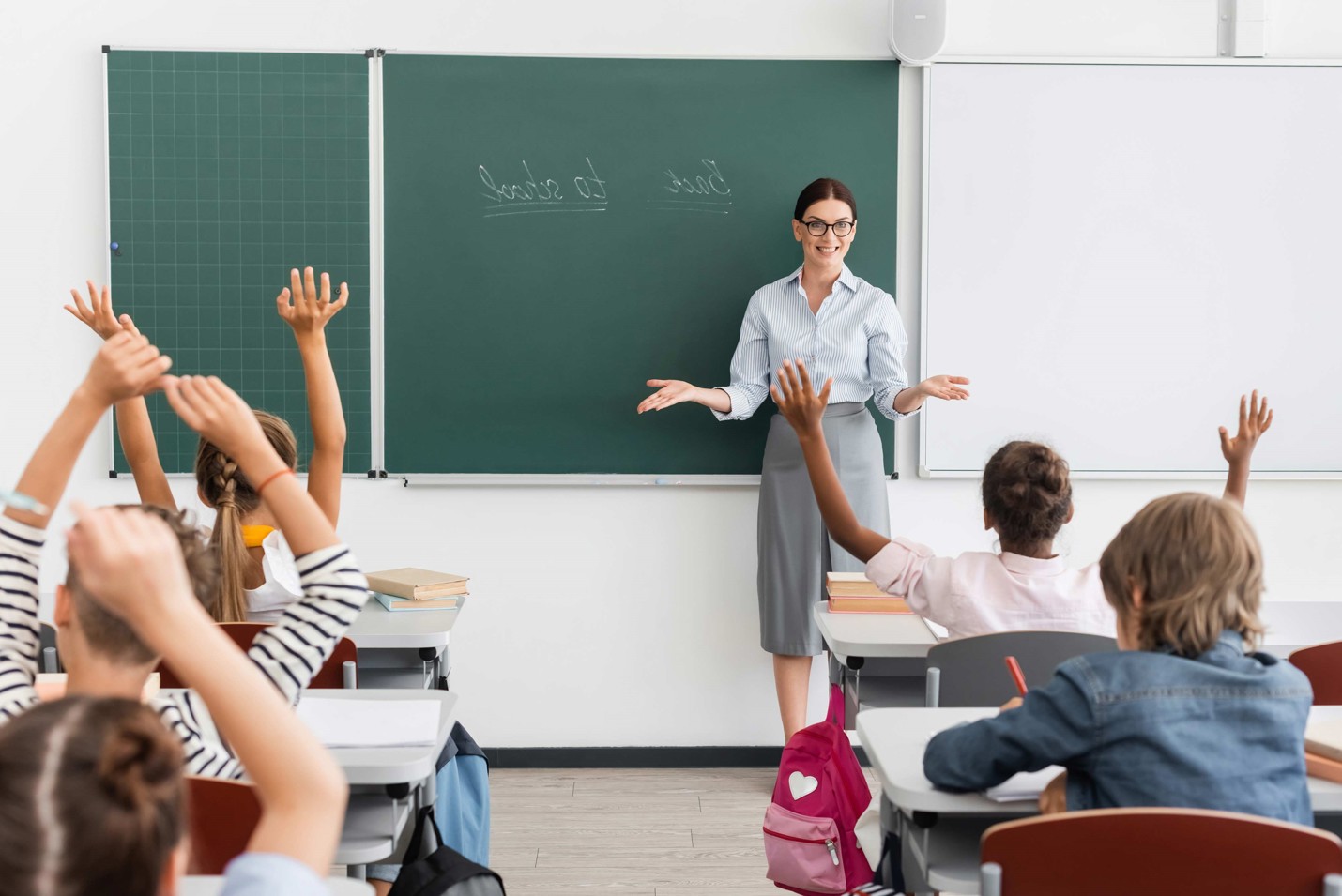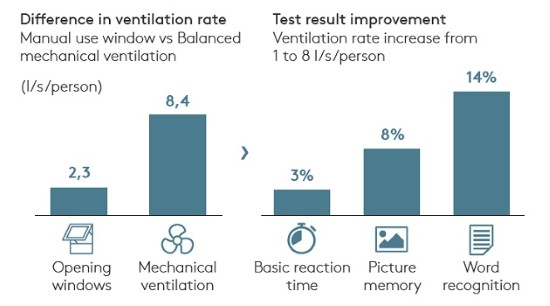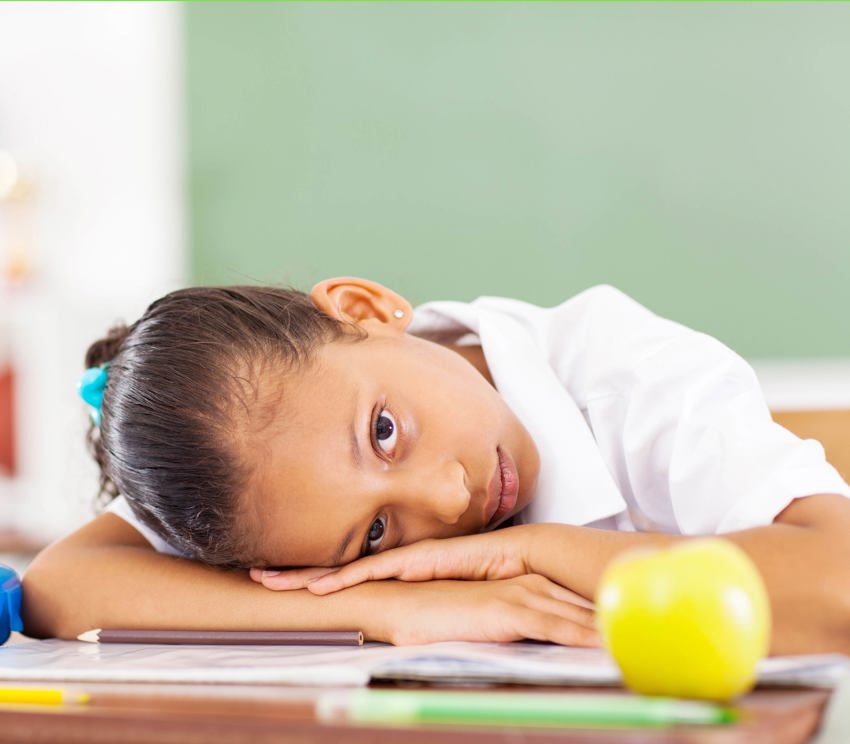At school
There is a unique aspect to children and schools, meaning that children's developing bodies may be more susceptible to environmental exposures than those of adults. Children breathe more air, eat more food and drink more fluids in proportion to their body weight than adults. That is why, when it comes to the indoor climate, the health and performance of children in schools is particularly important.

Over our lifetime, we spend a lot of time in school
- Educational stages and schools vary by country. Education systems across the globe require students to go to school between 175 and 220 days a year (or between 35 and 45 weeks). The average school day lasts from 5 to 8.5 hours.
- Generally, formal education can be estimated at 10-12 years minimum, 17-20 with tertiary studies, and it can also take up to 20 plus years with postgraduate education.
- In Europe and Northern America, it can be estimated that a person spends about 1/7 or even a quarter of their life at school. This is without taking education before orafter school into account. This corresponds to 8,765 hours and up to 175,300 hours of education, and consequently, the time is spent in schools.
Ventilation in schools
Ventilation in schools affects indoor air quality (IAQ), which is generally evaluated by temperature (for summer and winter periods), relative humidity, CO2 concentration and ventilation rates (or air change rates).
Keep in mind that IAQ is part of the indoor environmental quality (IEQ), which also includes other parameters (based on PMV and PPD), such as thermal comfort, daylight/light and sound conditions.
A modern school should have mechanically controlled ventilation to supply fresh air to meet the criteria of acceptable indoor air quality. Regulation of air volume or air change is according to demand and based on the occupancy. The level of CO2 is often used as an air quality indicator.
In schools, continuous monitoring should be used to check and control the indoor environment, using parameters such as temperature, CO2 and energy consumption.
Due to the extremely high temporary internal loads in school buildings, special attention must be paid to the comfort in summer. For example, during hot spells the use of sufficient night-time ventilation — mechanical and/or free cooling — and also effective shading of the glazing.

Better ventilation = better performance at school.
Now, all spaces and systems in schools should be in a dynamic relationship with all student activities in school buildings.
Space in schools
School design/spatial patterns, specific characteristics for education, and outdoor conditions greatly impact school buildings. Educational buildings require an effective strategy, and the flexibility of all spaces must still have the highest efficiency and adaptability in the future.
The popluation of a school community can be quite large, ranging from several hundred to several thousand students and employees. The number of students in a classroom can vary between 17 and 30 and there can be large differences in class size between countries.
There is a limited building requirement for space when specifying a classrooms' dimensions and volume - with respect to square meter or per student. Some research findings indicate the guided value of 0.6 - 3 square meter per student for large lecture rooms/auditorium. This does not take into account the floor area taken up by furniture.
Actual occupancy in schools
Actual occupancy data shows that classrooms are typically empty rather than occupied and are primarily occupied during school hours and more or less vacant on weekends and holidays.
School buildings are used approximately 30 weeks, or 200 days a year, with relatively long periods during which they are unoccupied and, in general, few activities take place on weekends and evenings, other than partial occupancy of sports halls, gyms or some cultural spaces.
The utilisation rates of schools are typically low or very low. This means that at any given time, most rooms are not in use in the school building, and ventilation could be minimised. On the other hand, when in use, the demand for ventilation, and equally for a good indoor climate, is very high.
Effects on learning in schools
The numbers don't lie
- Every 1°C reduction in overheating improves student learning performance by 2.3%.
- For every 1 litres per second per person (l/s/p) increase in ventilation rate up to 15 l/s/p, academic performance increases by 1%.
- Every 100 ppm decrease in CO2 concentration is associated with a 0.5% decrease in illness-related absence in schools.
- Every 100 lux in improved lighting in schools is associated with an increase of 2.9% in educational performance.
- Better daylight is associated with an increase of 9-18% in educational performance.
- For every 1 dBA reduction in excess noise, academic performance increases by 0.7%.
Increased ventilation improves results

This graph represents results from a study done on students — it shows that by moving from 'open-window' ventilation to a balanced mechanical ventilation, basic reaction time, basic memory and word recognition has a marked improvement.
Watch: Indoor air quality and the impact on school childrens' performance
Lecturer: David P. Wyon
Webinar recording from Swegon Air Academy, 2015.
In this video you will find information on how childrens' performance in schools is affected by air quality.
It summarises the findings:
- Warmth reduces childrens' performance: -3.5% per 1°C
- Poor ventilation reduces childrens' performance: half the outdoor air supply = -14.5%
"Temperature and air quality have both effects on performance. It isn't easy to distinguish what's going on. In winter, all windows are closed because it's too cold outside and children's work is degraded by air quality because the children aren't getting enough fresh air. While in summer, the windows are open to ensure good air quality, but the classroom warms up due to the sun, so the temperature reduces the children's performance. So children's time in schools is affected by poor air quality by almost 30%."
David P. Wyon, Researcher
Educating children in healthy classrooms
School teachers often tell parents that their children should not go to school if they are ill. But what if the children are just fine at home and when they are in the classroom they don't feel well and often complain without being able to say why?
The truth is that children often do not recognise or fail to explain clearly the reasons why they are feeling not well or when and where it started. They are simply too young and inexperienced to understand the complexities of health, various activities and different environments. All this experience and knowledge comes with the education that children will receive in schools and their lives.
Teachers and parents — as adults and caretakers — want the best for children in schools, so there are fewer health complaints and less absences in the classrooms. Hence, children would be more present and alert in their classes, and their performance will improve.


Air quality and ventilation in schools
The school building represents an excellent opportunity to intervene and protect the students' health. Students deserve to develop, learn and thrive in a healthy environment that optimises their potential to succeed and safeguard their well-being. The future needs healthy and smart school buildings with an excellent indoor environment for healthy air in schools.
Download our Research 'Air quality and ventilation in schools'
"Poor air quality is a significant disadvantage for children, and especially for slow workers. Because most children, just as adults do, reduce the speed of their work to maintain an acceptable level of accuracy."
David P. Wyon, researcher
Dig deeper in the topic from other authors
Children are not little adults. They have unique needs, sensitivities, and vulnerabilities, and it is becoming increasingly evident that current school building conditions may not be sufficiently protective of our students' developing bodies and minds.Schools for Health